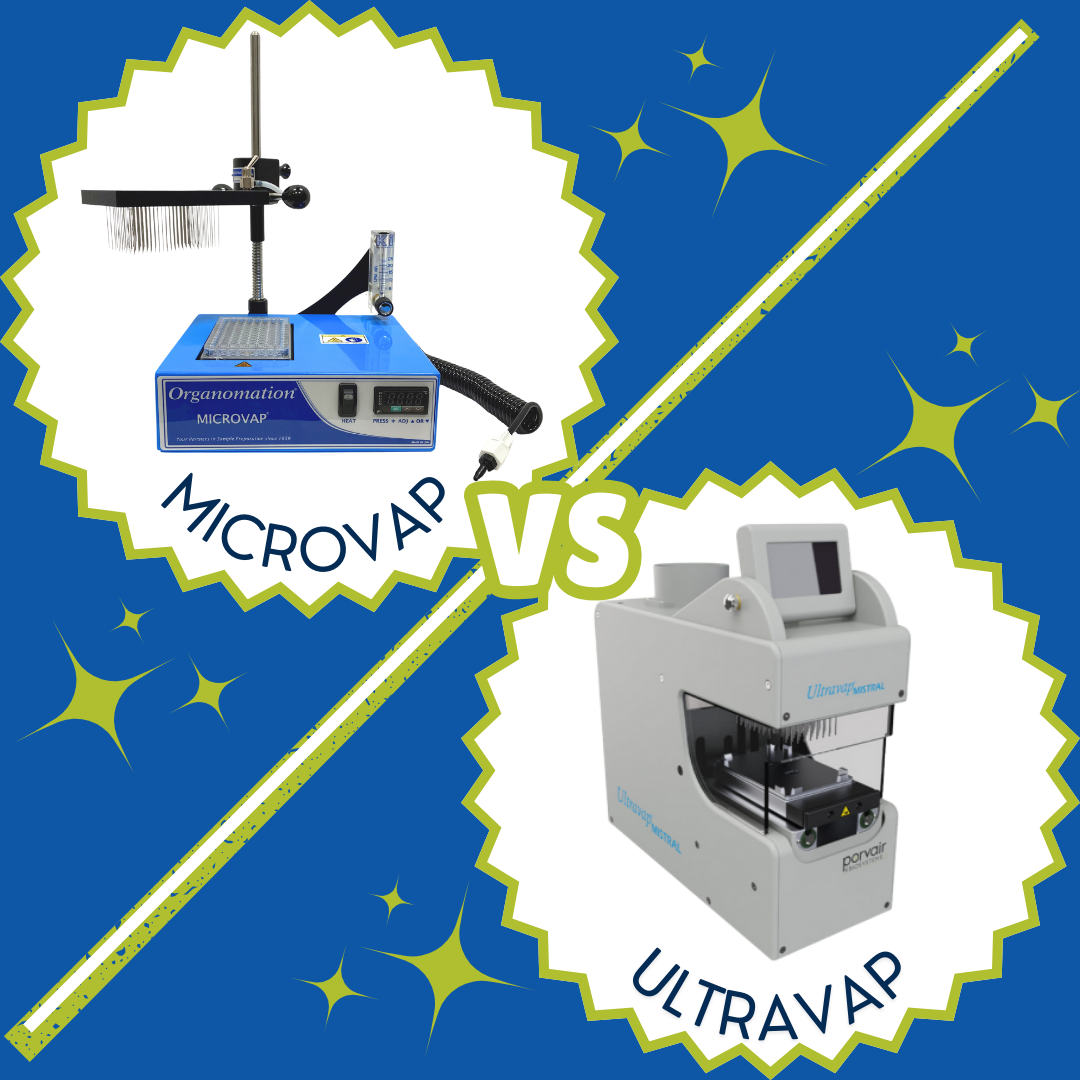Product Information, Sample Concentration Options
/ Organomation
Picking the right evaporator for your laboratory can be a challenge when you are overwhelmed with choices. This decision is important, and can determine your lab's throughput, capacity, and efficiency. In order to make the right choice, you'll need all the right information! This article explores the differences between the Organomation MICROVAP and the Porvair UltraVap, specifically highlighting their variations in price, temperature range, and resource consumption. Keep reading to determine which evaporator will be the perfect fit for your sample preparation needs!
Sample Capacity
The MICROVAP can hold 15 or 24 tubes, or up to three microplates. The UltraVap can hold 12, 24, or 48 test tubes, or up to two microplates. For high throughput laboratories, the large capacity UltraVaps may be the better suited solution. The UltraVaps allow you to evaporate up to 48 test tubes at once per manifold, whereas the MICROVAP holds up to 24. The UltraVap can also accommodate 384 well microplates, while the MICROVAP can only accommodate 96 well plates.
Price
For labs that have a limited budget such as start-ups or academic labs who are restricted by grant funding, the MICROVAP provides a much more affordable option than the UltraVap. Even the highest capacity MICROVAP with additional features is less than half the price of the base model UltraVap. The simplicity of Organomation’s units allow the cost of both the unit itself and the overall maintenance to remain low.
Be sure to download the PDF version of the Organomation MICROVAP vs the Porvair UltraVap to see actual pricing.
Nitrogen Consumption
The MICROVAP requires much less nitrogen flow than the UltraVap making it the better option for labs who
are looking to conserve their gas consumption. For comparison, the single plate UltraVaps require 60-90L/min of nitrogen while the single plate MICROVAPs only require up to 25 L/min. The models designed to hold test tubes, as opposed to microplates, use as low as 2 L/min. Whether you’re using nitrogen tanks or producing your own nitrogen with a generator, the minimal gas usage of the N-EVAP provides a much more affordable and economical option.
Temperature Range
Both the MICROVAP and the UltraVap can start their evaporation at ambient temperatures. However, the MICROVAPs utilize a solid aluminum heat block which allows the bath temperature to reach up to 130°C, whereas the UltraVap caps out between 60°C and 80°C, depending on the model. When working with solvents that have a boiling point above 80°C, such as heptane, acetonitrile, or toluene, the MICROVAP will be a more suitable option as it can reach much higher temperatures, promoting faster evaporation rates.
Safety with Corrosive Solvents
All MICROVAP units are available as an acid resistant version, coated with PTFE to prevent corrosion from strong acids, bases, or otherwise corrosive solvents. If you’ll be working with solvents such as hydrochloric acid, formic acid, or tetrahydrofuran, the PTFE-coated N-EVAP will provide a longer-lasting solution than the UltraVaps, which are not suitable for use with corrosive solvents.
Automation and Digital Features
Unlike the MICROVAP which has button-interfaced controls, the Mistral and Levante UltraVaps include a digital touch screen where you can control the heat and gas flow. The digital system allows you to save preferences and methods in the system for future use. Although entirely preference-based, the touch screen feature can provide a more modern
approach to the evaporation process.
Similarly, for labs that require a more hands-off evaporation experience, the UltraVap Mistral or Levante will be better solutions than the MICROVAP. Saved methods can be programmed to precisely move the samples closer to the gas delivery needles as the solvent level goes down. These UltraVap models are also equipped with an RS232 connection allowing it to be connected to a robot liquid handling station. This is a great option for labs who are looking to completely automate their sample dry downs.
The Mistral and Levante UltraVap models use the latest CAN BUS interface technology, allowing them to be controlled remotely through a network. This interface also allows any number of evaporator units to be connected together in series, setting one as the “master” and others as “puppet” units.
For labs that are just looking for a simple, plug-and-play solution, the MICROVAP is the best option for you. The MICROVAP is designed to be easy to use, even for those with little to no experience with nitrogen evaporators. It has the basic controls you need, without all the fancy automated features. Its simple, yet rugged, design allows there to be very minimal maintenance costs, and is proven to last upwards of 20-30 years.
Placement
The UltraVap Mistral and Levante models have the option to either be used within a fume hood, or to be connected to a ventilation system using an exhaust outlet on the top of the unit. If your lab has limited fume hood space or even no
fume hood at all, the UltraVap allows you to use it on just a regular benchtop workspace. The general recommendation is to always use the MICROVAP within a fume hood, however a portable fume extractor can also be used in instances where that’s not possible.
Conclusion
The MICROVAP is more affordable, has a higher temperature range, and is less prone to solvent corrosion. It also uses less nitrogen, and has a more streamlined design for ease of use. This simple design is what allows the MICROVAP to boast a long lifespan and minimal maintenance costs. The UltraVap features a higher capacity, more digital and automated features, remote access, and it can be used outside of a fume hood. Both units have their draws and their drawbacks, but only you can decide which one is the best fit for your lab!
